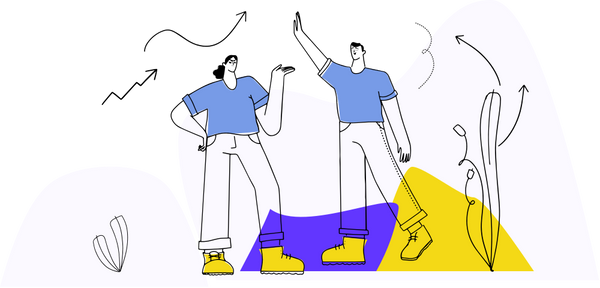This piece first appeared in Fast Company
The start of 2020 should have been an energizing time for me, personally and professionally. I had just returned from a long-awaited holiday honeymoon and closed a new round of funding for my startup. But I found myself lethargic, dreading my inbox, and procrastinating on important tasks—telltale signs of burnout.
In fits and starts, the tech industry has finally begun to talk openly about burnout, mental health, and workplace culture, including toxic leadership and unhealthy work hours.
Recently digital strategist Ella Dawson spoke openly in a personal essay of feeling “a boiling resentment of everything that asked for my energy: my job, my friends, my relationship, even my own body.” As the senior social media editor at TED, she set work boundaries, received promotions, and prioritized self-care but still found herself “treading water” just to get the bare minimum done.
She wasn’t alone: A survey of 11,000 tech workers on Blind found that 57% were currently feeling burned out. While not an evenly distributed sample, Blind’s stat stands in stark contrast to the mere quarter of American adults who say they’re burned out at least some of the time, in a study by the American Psychological Association. It seems even as tech companies work relentlessly to satisfy and delight their customers, many are willing to let a significant portion of their staff operate in a state of deep dissatisfaction.
Then in March, a global pandemic wreaked havoc on the global economy and day-to-day life, introducing a host of new challenges into the equation.
We’re now nearly three months into our new reality, trying to adapt to working from home while educating our children, staving off cabin fever, and being super vigilant whenever we venture outside. Don’t get me wrong: Tech workers should appreciate their immense privilege in being able to keep working with generous wages and strong job security, compared to workers in retail and hospitality, which have been devastated by the shelter-in-place and social distancing policies. But there’s no denying the pandemic has had a measurable impact on tech workers’ mental health.
An Early Wave of Burnout
“I feel like we went through a trough of despair in the first month,” said Alison Rowland, a principal software engineer at Stitch Fix. (Rowland and I are both on the board of a civic tech nonprofit.) Rowland explained over a call that while she had been a remote engineer throughout her time at the online personal shopping company, her husband typically worked from an office outside of the home. To go from working at home by herself to having her husband and her two children, ages 5 and 9, at home with her all the time took an adjustment that was “exhausting.”
Rowland’s experience mirrored broader data indicating that people are working longer and feeling more exhausted than ever. Amplitude, a product intelligence company, found that more users in California appeared to be working through lunch in April (24% versus 22% in January) and working later at night. (Eleven p.m. logins were up to 5% from 3%.)
These findings held up beyond the West Coast. BurnoutIndex.org, a free burnout assessment tool by workplace support platform Yerbo, confirmed these issues across more than 100,000 technology workers globally.
BurnoutIndex.org examined four indicators of burnout: exhaustion and fatigue, cynicism around work, depersonalization (lack of sympathy and emotional harshness), and loss of efficacy and productivity on a scale. While most of us may be familiar with how exhaustion and fatigue lead to burnout, the other three factors align closely to the revised definition of burnout in the WHO’s 11th International Classification of Diseases, as well as the Maslach Burnout Inventory, first defined in 1981 by UC Berkeley psychology professor Christina Maslach.
From February to March, signs of burnout rose among tech workers on all four indicators, with the highest being depersonalization, particularly with regard to the statement “I find myself being harsher emotionally with others,” which rose 17% in just one month.
I saw this in my own life, as I found myself getting angry at my cofounder and he and I began getting into more heated discussions, something that’s happened only a handful of times in our years of working together.
The Impact on Leaders
It turns out I wasn’t the only founder who was struggling. I spoke with Amy Buechler, the former batch director of Y Combinator who offers executive coaching to founders whose companies range from 7 to 800 employees. Her clients, who are typically the CEO or CTO of their companies, all went through “a grieving process” as the pandemic radically transformed the state and future of their business.
“These founders had to mourn the company they had lost so they could see the company they now led,” she told me. “They had to make sense of their loss, make hard decisions, and create new hopes for the future.”
All of Buechler’s clients had to reduce headcount, completely restructure their business, or both. At my company, Midgame, we needed to reinvent our product after usage changed dramatically as locked-down users demanded a new set of social and entertainment experiences. Across the industry, Bloomberg reports that tech companies have shed 40,000 total jobs as of May 28. Meanwhile, Twitter, Shopify, Coinbase, and others have halted new office development and are gearing for a remote-first future.
Even the companies that experienced a bump in demand from the pandemic still face challenges. Bravely is an on-demand coaching platform that employers can offer as a benefit to employees. According to CEO Toby Hervey, the firm has seen both an increase in demand for their services and a 146% increase in usage among existing clients, with the number-one theme of these coaching calls being “stress related to the impact of COVID-19.”
“We’re lucky to have this influx, but things haven’t been easy either,” said Hervey. “We froze hiring for a while, which put a lot more on everyone’s plates while trying to deal with the pandemic and adjust to remote work.”
An Uneven Recovery
The silver lining is that things are starting to stabilize. As early as April, data from BurnoutIndex.org found that worker burnout indicators were starting to decline from their March peak.
“The jump of the burnout phenomenon in March was utterly remarkable,” said Carlos Sponton, who has an MSc in work psychology and is the head of behavioral science at Yerbo, commenting on the impact of COVID-19. “Then in April, we could see resilience and adaptation appear in reaction to the new purpose.”
But even as overall burnout scores came down, exhaustion fell a mere 1% and had an absolute score of 4.1 out of 6, which made it the highest of the four factors. This suggests that workload still hasn’t landed at a sustainable level, as employees continue to report feeling run-down.
Instead, what’s driving the overall burnout recovery seen in the BurnoutIndex.org figures is an improvement in two other factors: cynicism and depersonalization. Both fell around 12%, with April numbers (2.9 and 2.5, respectively, in terms of absolute scores) reaching well below their February baselines.
This trend is reflected in Rowland’s experience—she saw some of her coworkers struggling to find meaning in their professional lives at the start of the crisis. “You’d see people express things like ‘I’m not even sure why I come to work,’” Rowland said. “But as people got more used to the situations in their home life, it became easier to look to work as an outlet and purpose.”
This recovery is not evenly distributed. For instance, with many camps and summer programs canceled, parents continue to struggle with caring for their kids. And on top of work, Black tech employees must deal with the stress and emotional burden emerging in this moment of national reckoning against racism and police violence, as well as having to educate their coworkers on issues of race and social justice.
Still, the overall trend is encouraging. I’ve written before about how burnout is often more driven by the loss of meaning than too much work. It looks as though work engagement through the pandemic is responding in a similar fashion.
How Leaders Can Help their Teams Fight Burnout
What can corporations do to stave off burnout in this period? Here are some suggestions from our experts:
- Provide mandatory planned time off. Hervey gave Bravely staff four straight weeks of half-day Fridays. “People feel like there’s no end in sight,” he said. Letting workers know in advance they have chances to rest can help them “ride it out for the long haul.”
- Acknowledge that things are weird and hard. Both Rowland and Buechler underscored the importance of having managers and executives who spoke openly about the uncertainty of the moment and shared some personal vulnerability.
- Lean into pulse/culture surveys: It’s both difficult and important to stay on top of your team’s well-being during a pandemic and while working remotely. Products such as CultureAmp, Know Your Team, and Yerbo’s TalkIt can serve this purpose by offering weekly or semi-monthly surveys where employees can share how they feel about their job and their company. The results are often aggregated anonymously so staff members feel comfortable being honest while leaders can spot trends and areas to watch out for.
- Create a space to discuss difficult topics: Taylor McCaslin, a senior PM at GitLab, shared how the company’s #mental_health_aware Slack channel has been an important place to bond with her coworkers. More than 200 GitLab employees use it to share honest feelings and helpful resources around mental health. “It’s been so eye-opening to see the struggles that other people have and to see that I’m not alone,” McCaslin said. Rowland echoed these sentiments and said that Stitch Fix similarly introduced a new Slack channel where people could be vulnerable about personal challenges or difficult emotions.
- Empower employees to take mental health days. Many companies offer generous sick leave, but managers should clarify that this can be used for both physical illness and mental well-being. Both my cofounder and one of our engineers took a few mental health days during the months of February and March and came back far more energized and productive, and appreciative of our culture as a result.
As in every industry, tech has taken some hits during the pandemic, but we’re starting to pick ourselves back up. But a second wave of infections appears all but inevitable, and it remains to be seen if tech employees can stay engaged with our work even as COVID-19 continues to transform our society.
Image created by Croods via Vijay Verma

